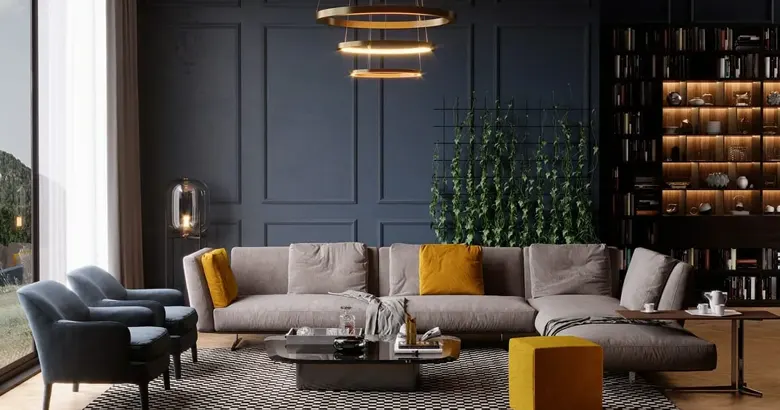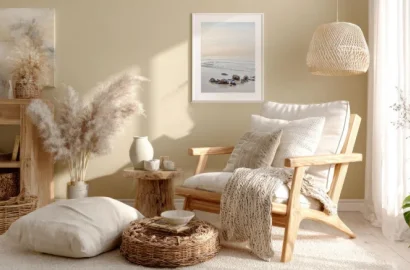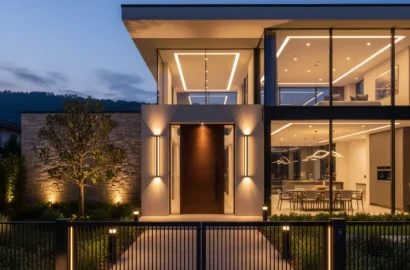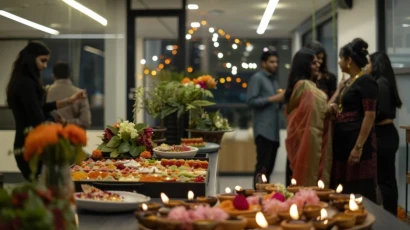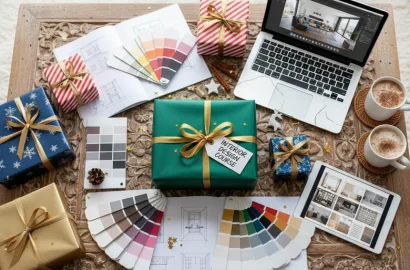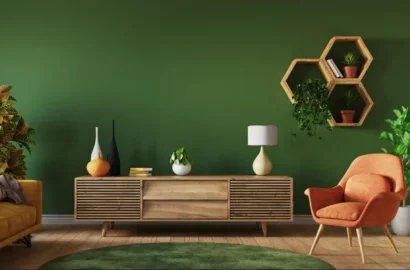Learn everything there is to know about residential interior design, from understanding its purpose to exploring different design styles. Also, find practical steps to implement residential design ideas for your next project.
Do you find yourself constantly on the lookout for the latest home decor pieces, materials and finishes? Does designing residences make you feel like you’d want to do this for the rest of your life? If so, then residential interior design might just be your calling.
It is a rewarding, creative and impactful role in the domain of interior design that specifically deals with homes. In this article, we cover what exactly is the field of residential interior design, discuss popular residential interior design styles doing the round, and provide tips to incorporate these styles into your design or home.
By the end of this article, you’ll have more clarity about the know-how of residential interior design and whether it aligns with your career aspirations.
Contents:
- What Is Residential Interior Design?
- Characteristics of Residential Interior Design
- Which Styles Are Used in Residential Interior Design?
- Tips to Incorporate Residential Interior Design Ideas
- Way Forward
- Next Steps
What Is Residential Interior Design?
Residential interior design is a specialized creative field associated with making homes, or parts of them, functional, visually appealing, accessible, and safe. It involves identifying the potential of a space and making the best use of it, prioritizing client needs, and balancing them with the right aesthetics. While some may perceive residential interior design as a mere act of choosing and arranging furniture pieces, there is so much more that it has to offer. It evaluates the practicality of every design element, infuses them with design theories and curates the most efficient solution.
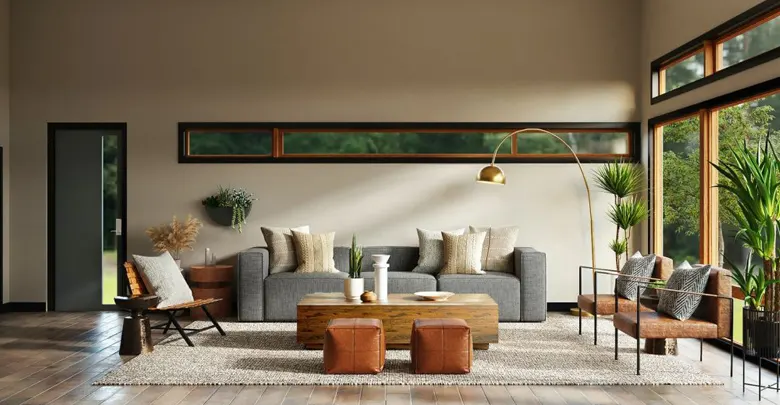
Image Source – Stewart-Schafer
i. What’s the Purpose of Residential Interior Design?
The purpose of residential interior design is to create an authentic space that you can call your own – one that corresponds to your needs and reflects your preferences and tastes. Its primary focus is to translate client ideas into reality by improving the living conditions of a space by maximizing comfort and well-being. Focusing on aspects like accessibility, movement, and lighting conditions, as much as color schemes, material palettes and design styles, often helps derive a solution that is not only visually impactful but functionally sound.
ii. How Is It Different From Commercial Interior Design?
Although both residential and commercial interior design deal with the inside spaces of buildings, each has its unique design requirements. From the furniture sourced to the fabrics picked to the approach to floor layouts, there exists a fundamental difference.
Scope: While the scope of residential interior design is limited to bungalows, condos or apartments, commercial interior design has a wider scope and deals with public spaces, including offices, hotels, restaurants, hospitals, retail stores, and community centers, that individually require a customized solution.
Needs: Residential interior design emphasizes the preferences and styles of the residents by personalizing living, kitchen, dining and bedroom spaces, whereas commercial interior design is centered around a brand image and focuses on the customer or visitor. The layouts for commercial interior design are much larger, and aspects like building codes, permits, and budgets need to be considered.
Experience: Another major difference is the user experience each of these interior design types creates. Residential interior design creates safe, accessible, comfortable, and personalized spaces for a particular family, while commercial interior design focuses on improving the customer or visitor experience.
Design goal: The objective of residential interior design is to meet the needs of individual users, but in commercial interior design, the focus is attracting a larger group of people from diverse backgrounds to meet the return on investment for business purposes.
Characteristics of Residential Interior Design
Residential interior design places a strong emphasis on the functions of individual rooms, ensuring layouts are practical and efficient for everyday living. Comfort, aesthetics, placement of furniture and adaptability to changing needs, work together to create a distinctive and holistic design.
Let’s go through some features that are typical to this interior design specialization in detail.
Premium Materials and Finishes
Premium materials like wood, marble and quality fabrics not only improve the aesthetic value of a space but also improve the tactile experience, adding a sense of luxury and class. They offer a longer lifespan for furnishings and surfaces and create better living experiences.
Attention To Detail
Every detail matters when it comes to residential interior design. From furniture placement and furnishings to design elements and accessories, attention to detail ensures spatial efficiency both in terms of style and functionality. The careful curation of elements improves the aesthetic and functional value of the space.
Impeccable Craftsmanship
Detailed and precise craftsmanship ensures the longevity and durability of components. It improves the visual appeal while imparting exclusivity to each and every element.

Which Styles Are Used in Residential Interior Design?
If you’ve ever looked up residential interior design ideas, you must have encountered a variety of styles. Each of these styles has distinctive characteristics, themes, color schemes, material palettes, and furniture types. Whether you’re looking for a classical theme, a rustic vibe, or a minimal look, there is something for every preference and taste. Come with us for an exploration of the most popular residential interior design styles that are making waves.
i. Modern Interior Design Style

Image Courtesy: Architectural Digest
Many of us tend to consider modern and contemporary design styles synonymous, but they have several distinct characteristics. Modern interior design style, unlike its contemporary counterpart, refers to a specific time period from the early to mid-20th century. It is a precursor to the contemporary style and is defined by clean geometries, minimalism, toned-down color palettes, and an emphasis on function. Heavily influenced by Scandinavian, mid-century modern, and post-modern styles, it often incorporates glass, steel and concrete, using large windows and open floor plans.
ii. Contemporary Interior Design Style
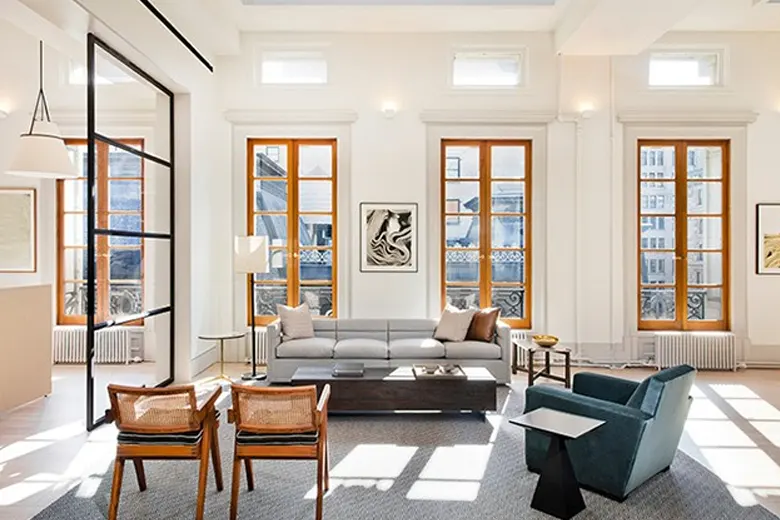
Image Courtesy: Decoraid
Contemporary interior design style isn’t defined by any time period – it is known to evolve constantly and is more fluid and dynamic, reflecting the present-day style. It often borrows certain qualities from minimalism, classical, modernism, and many other global styles and combines them to form an unconventional style. Although it is ambiguous in nature, some prominent qualities help identify a contemporary style – open floor plans, use of natural light, neutral palettes like white, beige, and grey, clean lines, vibrant pop-off colors, textiles, rustic materials, and multi-use furniture.
iii. Traditional Interior Design Style
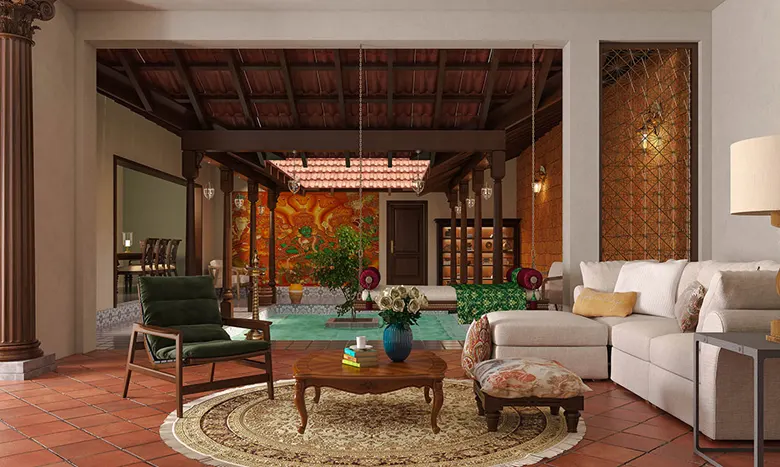
Image Courtesy: Design Cafe
The traditional interior design style is defined by a classical and timeless look. Think intricate ornamentation, antique furniture, as well as warm and rich colors, patterns, and textures, that add depth to a space. It is ideal for those who appreciate the old-world charm and traditional art over modernism. Designed on the principles of vibrancy and symmetry, this style embraces the use of luxurious textiles.
iv. Transitional Interior Design Style
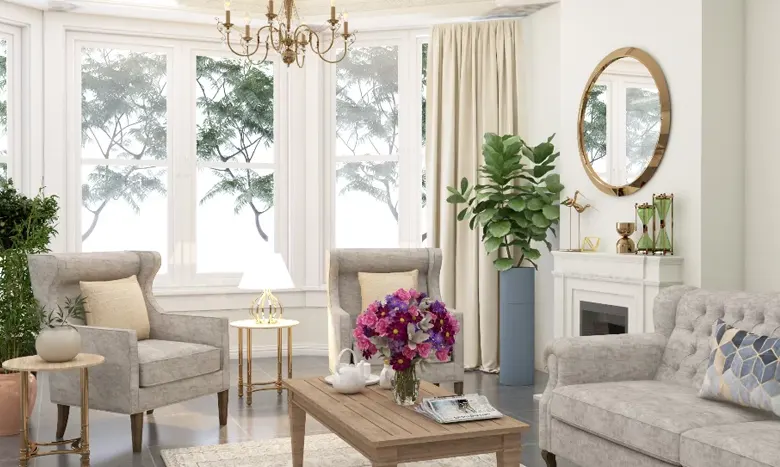
Image Courtesy: Foyr
Another popular design style among the present generation is the transitional interior design style. If you like particular features of both traditional and contemporary styles, this style is a great choice for you. Residential interior designers can establish balance by focussing on creating a style that’s the best of both worlds. Some characteristics of this style are distinct focal points, clean lines, a fondness for minimalism, metallic accents, use of textures, minimum accessories, and curved furniture with finishes like rattan, wood, and steel.
v. Minimalist Interior Design Style
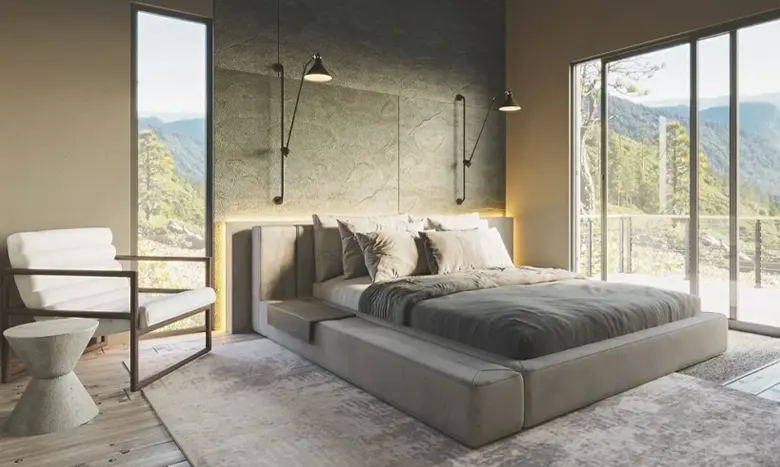
Image Courtesy: Decorilla
Minimalist interior design style shares similarities with contemporary style but draws inspiration from the Japanese design philosophy of “less is more.” While most minimalist interiors have a neutral color scheme, sometimes primary colors are used as accent walls or to highlight a corner. This style leans towards a minimum to no use of patterns while emphasizing textures and prioritizing functionality. Essential to this approach is the incorporation of multi-use furniture, ensuring increased storage capacity and a clutter-free environment with nothing in excess.
vi. Bohemian Interior Design Style
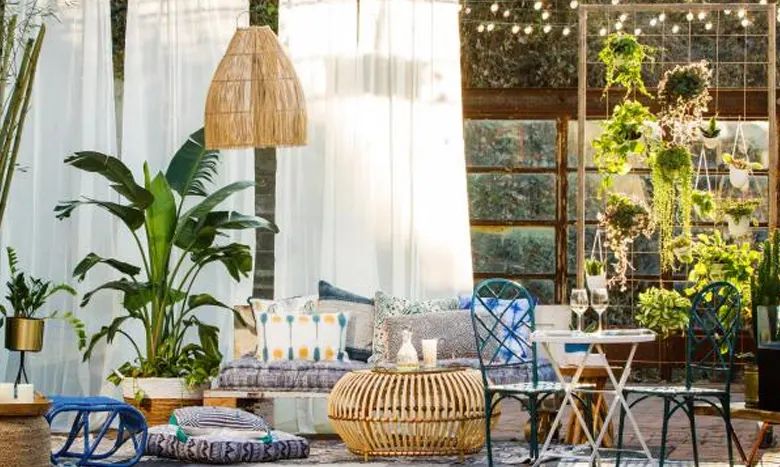
Image Courtesy: Hgtv
Bohemian interior design style is another style that is widely popular among the younger generation, so much so that retailers have also joined the boho trend, developing furnishings and accessories that complement this style. It is essentially a free-spirited style where the aesthetics are a blend of diverse cultural backgrounds and artistic expressions, not confined to any boundaries. You can spot bold patterns and vibrant colors for furniture and accents. This style is a lot about layering and creating patterns. It is one of the few design styles that doesn’t follow an order of things.
vii. Rustic Interior Design Style
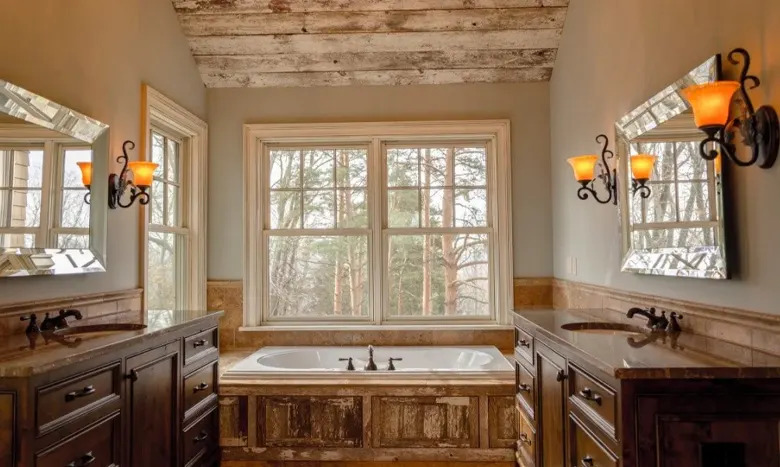
Image Courtesy: Vevano
Rustic interiors take inspiration from nature and incorporate elements like wood, stone, and natural fibers. This style is characterized by soft, earthy tones like brown, tan, beige, and gold and is known for its rough and unfinished look of surfaces and materials. The rustic design creates a cozy and comfortable vibe, often using lots of natural light and comfy fabrics.
4. Tips to Incorporate Residential Interior Design Ideas Into a Living Space
To achieve desirable residential interiors, you need to focus on designing and curating a space that is big on quality, comfort, aesthetics, and personalization. This involves attention to detail, whether it is the major decisions like planning layouts and material selection or minor ones like incorporating accessories and decor pieces.
Here are some tips that will not only help you create spaces that look and feel great but also meet the requirements of a comfortable experience.

Image Courtesy: Ogling Inches
i. Identify and Define Your Interior Style
The first step is to familiarise yourself with diverse design styles and discover the one that resonates with your or your client’s preference. There are a variety of design styles ranging from classical and rustic to contemporary and minimalist. Each style has its individual characteristics, color schemes, furniture types, and design elements that contribute to creating an ambiance that is an extension of the personality of those who occupy the space.
ii. Strategically Plan Your Layout
A functional layout ensures a comfortable flow of activities and justifies the intended purpose behind the design. Analyze the sources of natural light because it has the potential to influence one’s mood and determine how one feels within a space. Observe the window sizes, orientation and how much sunlight enters the rooms. This information helps you decide on the color schemes, window treatments and furniture placements. Also, consider focal points and movement patterns and plan the arrangement of furniture accordingly.
When planning the layout, it is also important to analyze the functions and requirements of different spaces.
Kitchen: Focus on an efficient layout that optimizes easy movement. Consider the placement of appliances, cooking counters, and ample storage solutions for utensils, groceries and appliances.
Living room: Consider the primary activities such as entertainment, relaxation, and socializing and design a layout that ensures comfortable seating areas, appropriate furniture placements, and a smooth traffic flow. Pick appropriate furniture sizes, select the right finishing materials, and adorn the area with refined decor pieces. Also, incorporate adequate storage solutions to keep the area clutter-free and organized. You can also build a focal point with an accent wall.
Bedrooms: Decide on the position of the bed and plan the rest of the furniture and storage solutions for a clutter-free look. Also, analyze individual preferences for personalized design elements. Think texture – introduce a chic rug, layer the bed with a pile of cushions, add a mirror and lamps for the character, and elevate the visual appeal with an eye-catching headboard.
Bathrooms: Demarcate the wet and dry areas of the bathrooms and decide on the positions of bathroom fixtures to ensure easy and safe access.
iii. Be Mindful of Natural and Artificial Light
Lighting is a primary factor that influences the way textures, elements and silhouettes appear. Good natural lighting induces comfort and improves the well-being of occupants while also adding a touch of drama to a space. It creates depth and draws attention to the visually impressive areas. Observing the amount of light that enters a room can help you decide how to position furniture and other elements, creating a balance of light and shade.
Artificial lighting is equally important as it improves functionality and adds character to different rooms through a range of lighting options. Different lighting fixtures serve different purposes. For example, if you want to highlight an artwork on a wall, opt for a focused accent downlight to draw attention. If you’re going to light up the dining space, use a hanging downlight and if you want to create a reading nook in the bedroom, use a table lamp. Additionally, lighting choices, such as floor lights, wall lights, strip lights and concealed lights, offer versatile solutions to amp up the overall ambiance.
When planning the lighting design, aim for a harmonious blend of various lighting types to attain the desired effect. More importantly, pay attention to the color temperatures of the light bulbs, as warm or cool tones can greatly influence the ambiance of the room or space.
iv. Consider the Effects of Colour Psychology on Well-Being
Color is the first thing that grabs your attention when you enter a space. It is the most relatable aspect that familiarises occupants of all age groups and one of the easiest ways to make a statement.
Colour theory in design is the study of how colors impact our emotions and moods and influence the way we feel and behave. It can evoke certain feelings and set the tone of a space. While some colors may have symbolic meanings, the associations with colors can be different for different people based on personal experiences and cultural influences. As a residential interior designer, having an awareness of the psychological effects of colors and using them accurately through conversations with the users can help you craft comfortable experiences.
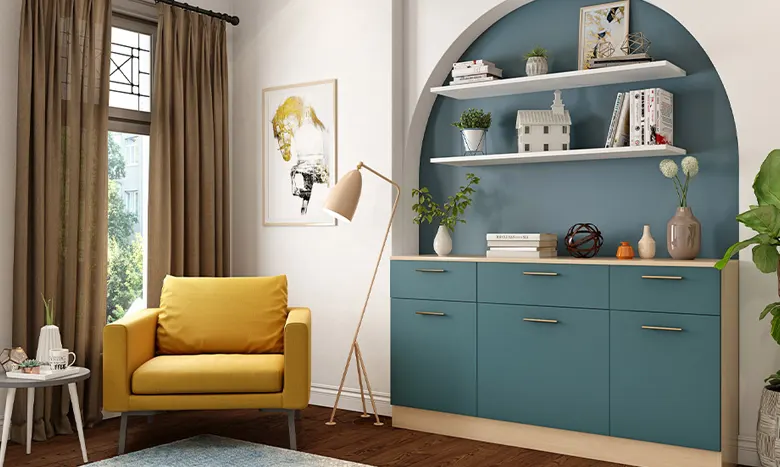
Image Courtesy: Design Cafe
iv. Furniture and Decor
Customized premium furniture and handpicked elements like a stunning sofa, an accent chair, or a luxurious bed can improve the visual quality of a space. Go for larger and unusual pieces that resonate with your design style, carry more elegance and are proportionate to the size of the rooms.
Statement art pieces add a luxurious touch and transform an ordinary space into an exclusive one. Investing in a few good decor pieces is better than cluttering the room with several mediocre ones. You can also create a gallery wall of curated pieces that reflect your personality.
v. Flooring and Wall Treatment
There are different flooring options that you can choose based on your layout, design aesthetic and the desired level of luxury. Some of the options include terracotta tiling, hardwood flooring, porcelain or ceramic tiles, marble flooring, vinyl flooring and terrazzo flooring.
Creative wall treatments can transform the look and feel of residential spaces. Here’s a list of wall treatment options that you can consider for your next project:
Accent walls – Use bold colors, patterns or textures on a single wall to create a focal point
Wallpapers – Choose from a variety of textures, patterns and finishes
Textured paint – Opt for textured paint to create depth and dimension
Wood paneling or wainscoting – Install wood panels or decorative paneling to add detail to your walls
Stone or brick cladding – Incorporate natural materials for a rustic or industrial look
Molding – Use decorative moldings to frame walls and ceilings
5. Way Forward
In this guide, we’ve covered the details of residential interior design – from breaking down what it means and laying emphasis on its purpose to exploring global design styles, as well as steps to implement residential interior design ideas in real-life projects or even in your own home. If you’d like to delve into more ideas for sprucing up different spaces within your home, consider the following resources:
- 32 Home Interior Design Ideas to Brighten Up Your Space in 2024
- 20 Amazing Modern Bedroom Interior Design Examples to Consider in 2024
- 4 Major Types of Interior Design (with examples) you should know about
If you’re intrigued by this dynamic field, want to pick up relevant skills, and learn how to create an effective portfolio, check out AND’s Interior Design Courses.
We also recommend checking out student work like this Residential Design Project by AND Learner Keerthi Viswanadha, for deeper insight into the practicalities of the field.
6. Next Steps
We hope our practical guide to residential interior design could inspire the designer within you. In case you need further assistance, here are some additional resources you can consider:
- Watch this session by Snehanshu Mukherjee, Founding Partner at T.E.A.M and Mansi Almadi, an Interior Designer at Studio Lotus
- Talk to a course advisor to discuss how you can transform your career with one of our courses.
- Check out our Interior Design courses – all courses are taught through live, interactive classes by industry experts.
- Take advantage of the scholarship and funding options that come with our courses to overcome any financial hurdle on the path of your career transformation.
Note: All information and/or data from external sources is believed to be accurate as of the date of publication.

